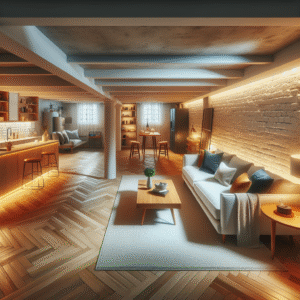Introduction to Reclaimed Wood: Why It’s a Sustainable Choice for Home Renovations
When it comes to enhancing your home, making sustainable choices is more crucial than ever. Reclaimed wood is not just a stylish material choice—it’s also an environmentally friendly option that adds unique character and storied history to any renovation project. As homeowners increasingly seek both beauty and responsibility in their construction materials, reclaimed wood stands out as the perfect solution. Utilizing salvaged wood not only helps reduce deforestation but also decreases landfill waste, making it a top choice for eco-conscious renovations.
Top 5 Benefits of Incorporating Reclaimed Wood in Your Home Design
- Eco-Friendly: Reduces the demand for new wood, preserving forests and natural resources.
- Rich History: Each piece has its own story, adding a unique depth and warmth to your home.
- Durability: Often sourced from old structures, reclaimed wood is typically harder and more stable than new wood.
- Visual Appeal: Offers a distinct, rustic look that is hard to replicate with new wood.
- Increases Home Value: Adds a distinctive architectural element to your home, which can be a selling point.
How to Source and Select Quality Reclaimed Wood for Your Renovation Projects
Finding the right reclaimed wood for your project involves knowing where to look and what to look for. Begin by visiting local salvage yards, antique shops, or specialty lumber stores that focus on recycled materials. Additionally, engaging with a reputable contractor who has experience in sourcing and working with reclaimed wood can provide invaluable guidance throughout your renovation journey.
When selecting reclaimed wood, pay attention to:
- Source of Wood: Ensure it comes from a reliable and ethical source.
- Condition: Check for signs of damage or excessive wear.
- Treatment History: Know if the wood has been treated with chemicals, which might not be suitable for indoor use.
- Size and Suitability: Confirm it fits your specific project needs in terms of dimensions and aesthetics.

If you’re ready to take your home improvement or construction project to the next level, we can help! Find trusted contractors on BuildNet, whether you’re looking for renovations, new builds, electrical work, plumbing, or anything in between. Our directory connects you with qualified professionals who can make your vision a reality.
Introduction to Reclaimed Wood: Why It’s a Sustainable Choice for Home Renovations
Hey there! If you’re pondering over materials for your next home renovation project and sustainability is a tick box for you, then you’re in the right spot. Let’s delve into the world of reclaimed wood, a gem in the realm of eco-friendly materials, and uncover why it’s becoming a go-to choice for environmentally conscious homeowners and designers alike. Whether you’re in bustling New York City, a cozy suburb of Chicago, or the scenic outskirts of San Francisco, reclaimed wood offers a universally compelling narrative to your home’s story.
What Exactly is Reclaimed Wood?
Reclaimed wood refers to timber that has been salvaged from its original application and repurposed for new use. It could come from a plethora of sources including old barns, factories, warehouses, railroad ties, or even ships. The beauty of reclaimed wood lies not just in its aesthetic appeal but in its story—every scratch, dent, and color variation is a testament to its historical saga.
Reclaimed Wood and Sustainability: A Match Made in Heaven
Choosing reclaimed wood is like giving the planet a little hug. Here’s why it’s such a sustainable choice:
- Reduces Demand for New Resources: By repurposing old wood, we decrease the need for newly harvested wood from forests, helping to preserve these critical ecosystems and reduce deforestation.
- Lowers Carbon Footprint: Processing new lumber not only uses more energy but also emits a higher amount of carbon. Reclaimed wood requires less processing to be repurposed and thus has a significantly lower carbon footprint.
- Decreases Landfill Waste: Utilizing reclaimed wood prevents it from being discarded in landfills, contributing to waste reduction and promoting a more circular economy.
- Conserves Historic Value: Many pieces of reclaimed wood come from buildings with historical significance. By using this wood in your home, you’re preserving a piece of history and contributing to its legacy.
- Supports Local Businesses: Often, sourcing reclaimed wood means partnering with local businesses and craftspeople who specialize in its salvage and sale. This not only boosts the local economy but also reduces transportation emissions.
Why Homeowners Love Reclaimed Wood
It’s not just the environmental benefits that make reclaimed wood a prime choice for home renovations. Homeowners across various locales—from the sunny coasts of Los Angeles to the historic streets of Boston—are falling in love with reclaimed wood for several other compelling reasons:
- Unique Aesthetic: With its distinctive appearance, reclaimed wood adds an irreplaceable character and warmth to any room. No two pieces are exactly alike!
- Versatility: This material can blend into any style, be it rustic, modern, or industrial. It’s perfect for flooring, walls, ceilings, and even custom furniture.
- Durability: Most reclaimed wood comes from old-growth trees and has already withstood the test of time, making it incredibly sturdy and resilient.
- Storytelling Element: Each piece has a story, and incorporating reclaimed wood into your home adds a narrative element that new materials simply can’t match.
Maximizing the Impact: Reclaimed Wood in Your Local Area
Regardless of where you live, incorporating reclaimed wood can have a significant impact. For instance, in urban areas like San Francisco or New York, using reclaimed wood can soften modern designs with a touch of rustic charm and historical depth. On the other hand, in regions like the Pacific Northwest or rural areas, it can emphasize the local heritage and natural surroundings.
Moreover, by opting for reclaimed wood from local sources, you are not only supporting local economies but also reducing transportation emissions, making your renovation project even greener. Many cities have local reclaimed wood suppliers or specialties that reflect the architectural history of the area—like oak from an old New England barn or cypress from a decommissioned ship in the Gulf Coast.
Embracing Reclaimed Wood: A Smart Choice
To sum it up, reclaimed wood is not just a material; it’s a sustainable, aesthetic, and durable choice that brings unique history and character to your home. It aligns flawlessly with the growing desire for sustainability while meeting the aesthetic and functional needs of modern homeowners. Whether you’re in a rural town or a major metropolitan area, reclaimed wood can enhance your home renovation project while aligning with your eco-friendly goals.
So, as you plan your next home improvement project, consider reclaimed wood not just for its beauty and durability, but also for the positive impact it has on our planet. It’s a choice that benefits both your home and the environment—a true win-win!

Top 5 Benefits of Incorporating Reclaimed Wood in Your Home Design
Welcome to the rustic and eco-friendly world of reclaimed wood! If you’re considering a home renovation and want to add a touch of authenticity and sustainability, reclaimed wood might just be the perfect material for you. Let’s dive into the top benefits of using reclaimed wood in your home design, making your spaces not only beautiful but environmentally conscious too.
1. Environmental Impact: A Sustainable Choice
Choosing reclaimed wood is a stellar way to reduce your environmental footprint. Why cut down more trees when you can repurpose wood that’s already played its part in a building or structure? By opting for reclaimed wood, you’re actively contributing to reducing deforestation and landfill waste. This eco-friendly choice helps preserve our precious natural resources, making your renovation project a testament to sustainability.
2. Unique Aesthetic Appeal
Every piece of reclaimed wood tells a story. Whether it’s from an old barn, a historic warehouse, or a dismantled ship, reclaimed wood brings with it a sense of history and character that new materials simply can’t match. The unique weathering, old nail holes, and rich patina add a warm, rustic charm to your home. This type of wood can transform any room, giving it a distinctive look that is both timeless and stylish.
3. Durability and Strength
Reclaimed wood isn’t just about good looks; it’s also incredibly durable. Wood that has been seasoned over the years is less likely to warp or split. This is because reclaimed wood has already been exposed to changes in humidity and has weathered naturally, making it more stable than fresh lumber. Choosing this material for your flooring, beams, or furniture means investing in a product that will stand the test of time.
4. Increase in Home Value
Incorporating reclaimed wood into your home isn’t just a personal style statement; it’s also a smart investment. Homes that feature reclaimed wood often see an increase in market value. Real estate buyers are typically drawn to homes with unique features and sustainable materials, making a reclaimed wood accent wall or hardwood floor a lucrative addition to your property. It’s a win-win: you enjoy the aesthetic and environmental benefits now, and if you ever decide to sell, your home may be more attractive to potential buyers.
5. Versatility in Design
One of the great things about reclaimed wood is its versatility. Whether you’re aiming for a modern minimalistic look or a traditional country feel, reclaimed wood fits wonderfully with any design theme. It can be used in a myriad of ways throughout your home—from a rustic kitchen island to a sleek, contemporary coffee table. The natural elements of the wood allow it to complement a variety of color schemes and design elements, making it a highly adaptable option for any renovation project.
In conclusion, incorporating reclaimed wood into your home design not only makes your space more beautiful and unique but also contributes positively to the environment. With its durability, aesthetic appeal, and versatility, reclaimed wood is a choice that you and your home will cherish for years to come. Ready to start your sustainable renovation? Let’s make your home a showcase of eco-friendly elegance with reclaimed wood!
How to Source and Select Quality Reclaimed Wood for Your Renovation Projects
Hey there! If you’re planning to bring a touch of authenticity and environmental consciousness to your home renovation, incorporating reclaimed wood might be just the ticket. But before you start dreaming of rustic beams and vintage floorboards, let’s talk about how you can source and select the best reclaimed wood that not only looks good but also contributes positively to your project. Here’s a step-by-step guide to help you find the perfect reclaimed wood for your next home improvement undertaking.
Finding Reclaimed Wood: Where to Look
First things first, where do you find quality reclaimed wood? It’s all about knowing the right places to look and asking the right questions. Here are some tried and true sources:
- Salvage Yards: These are gold mines for reclaimed wood. Salvage yards specialize in recovering materials from demolitions and renovations. Not only can you find wood here, but also unique historical pieces with stories to tell.
- Specialty Stores: Some retailers focus specifically on reclaimed lumber. These places often have a more curated selection, possibly sorted by type, age, or source of the wood.
- Online Marketplaces: Websites like Craigslist, eBay, and even Facebook Marketplace can be great resources. You might stumble upon a local who’s getting rid of old barn wood or selling beams from a recent renovation.
- Local Farms and Industrial Areas: Sometimes, contacting local farms or looking around old industrial sites can yield reclaimed wood treasures. Always make sure to get permission and negotiate terms before removing any materials.
- Community Boards and Forums: Keep an eye on community boards and online forums focused on DIY and renovation. Often, people will offer up materials they no longer need, which can include some fantastic reclaimed wood.
Assessing the Quality of Reclaimed Wood
Not all reclaimed wood is created equal. Here’s how you can ensure that the wood you select will stand the test of time:
Check for Damage
Inspect each piece for signs of damage. Common issues include rot, excessive warping, and infestation by pests. Minor imperfections like nail holes or surface scratches often add character but avoid wood that’s structurally compromised.
Know Your Wood Types
Different types of wood have different qualities and uses. Hardwoods like oak, maple, and cherry are durable and ideal for floors and furniture. Softwoods like pine are better suited for projects where a rustic look is desired but heavy wear isn’t expected.
Consider the Source
Understanding where your reclaimed wood comes from can help you assess its quality. Wood reclaimed from old warehouses or barns is likely to be old-growth timber, which is denser and more durable than new wood.
Preparing Reclaimed Wood for Use
Once you’ve sourced your reclaimed wood, it’s time to get it ready for your project. Preparation typically involves:
Cleaning
Start by gently cleaning your wood with a brush or a damp cloth to remove dirt and debris. Avoid using harsh chemicals or water jets that might damage the wood.
Removing Nails and Other Metal
Safety first! Make sure to remove all nails, screws, and other metal pieces from the wood. This not only makes the wood safer to work with but also prevents damage to your tools later on.
Sanding and Treating
Depending on your project, you may want to sand down the wood to reveal a fresh surface underneath the aged exterior. After sanding, treating the wood with a sealant or oil can help preserve its beauty and integrity.
Local vs. Non-Local Wood
While sourcing reclaimed wood, consider the benefits of choosing local materials:
- Support Local Businesses: Buying locally helps support local artisans and businesses, which in turn benefits the local economy.
- Reduce Your Carbon Footprint: Local wood doesn’t have to travel far, which reduces transportation emissions and energy use.
- Local Character: Wood reclaimed in your area will reflect the local history and architectural style, adding a layer of local charm to your project.
Finding and preparing the right reclaimed wood for your renovation project can be incredibly rewarding. Not only do you end up with a piece of history in your home, but you also contribute to conservation efforts by reducing demand for new raw materials. So, take your time to source carefully, prepare thoroughly, and enjoy the unique beauty and story your reclaimed wood brings to your space. Happy renovating!

FAQ: Everything You Need to Know About Using Reclaimed Wood
What is reclaimed wood?
Reclaimed wood is lumber that has been previously used in buildings or other structures and has been salvaged for reuse. It’s popular in home renovations and custom furniture because of its unique character and eco-friendly credentials.
Why should I consider reclaimed wood for my home renovation?
Using reclaimed wood is a sustainable choice that helps reduce the demand for newly harvested wood, minimizes waste, and often features a distinct, rustic aesthetic that can add character and warmth to your home.
What are the top benefits of using reclaimed wood in home design?
- Eco-Friendly: Reduces deforestation by reusing materials.
- Unique Aesthetic: Offers a distinct look with history and character.
- Durability: Often made from old-growth timber, making it more stable and durable.
- Increases Home Value: Can add a unique selling point and aesthetic appeal to your property.
- Story Element: Each piece has a story, adding a narrative element to your home.
How do I source quality reclaimed wood?
To find quality reclaimed wood, start by checking local salvage yards, specialty wood suppliers, and online marketplaces. It’s important to inspect the wood for signs of damage such as rot, insects, or excessive warping.
How can I verify the quality of reclaimed wood?
Look for wood that is structurally sound, free of pests, and has minimal rot. Ask suppliers about the origin and history of the wood, and whether it has been treated for pests and rot.
Can reclaimed wood be used in all areas of home renovation?
Yes, reclaimed wood is versatile and can be used in various applications including flooring, wall paneling, beams, furniture, and decorative accents. However, its use should be tailored to the specific requirements of each application, considering factors like exposure to moisture and structural needs.
Is reclaimed wood more expensive than new wood?
It can be, depending on the type and quality of the wood. While some reclaimed wood may be competitively priced, rare or highly desirable old-growth timber can be more expensive due to its quality, durability, and unique aesthetics.
How do I maintain reclaimed wood?
Maintenance requirements for reclaimed wood depend on its use and finish. Regular dusting, occasional cleaning with a wood-safe cleaner, and periodic resealing (if necessary) can help maintain its beauty and longevity.
Is it necessary to treat reclaimed wood for safety?
Yes, especially if the wood will be used indoors. Treatment might include cleaning, drying, and applying a finish to protect against moisture and pests. It’s also important to ensure the wood does not contain harmful residues from previous treatments.
Can I install reclaimed wood myself or should I hire a professional?
While DIY installation is possible for simpler projects, professional installation is recommended for more complex applications like flooring or structural supports to ensure safety and quality results. Contractors can also provide valuable advice on the best uses and treatments for reclaimed wood.
Conclusion
Incorporating reclaimed wood into your home not only offers aesthetic and environmental benefits but also brings a piece of history into your living space. With its unique characteristics and robust nature, reclaimed wood can be a fantastic choice for anyone looking to enhance their home’s design while being mindful of their environmental impact. When planning your next renovation project, consider the rich textures and stories that reclaimed wood brings.
Remember, while selecting and installing reclaimed wood, it’s beneficial to consult with professionals who can provide insights and ensure your renovation meets both your design needs and safety standards. For expert advice and a free quote, don’t hesitate to reach out to a contractor on the BuildNet website. Let’s make your home renovation project not only stylish but also sustainable!







